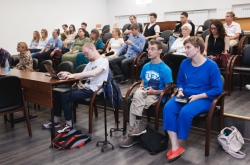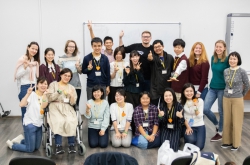WUD@ITMO is St. Petersburg’s sole professional event dedicated to World Usability Day. The event is organized by ITMO’s Faculty of Software Engineering and Computer Systems and Center of Usability and Mixed Reality and, on the past three occasions, has been held in cooperation with the university’s Office for Development of Alumni Community.
For a decade now, the conference has provided networking opportunities for UX/UI experts and current students and graduates of ITMO’s programs in the field. This year's conference focused on digital inclusion – the adaptation of services to meet the needs of people with disabilities.
“This year, we introduced a section on inclusion into our event’s program to let our fellow designers, who represent the Russian inclusion community, speak about web accessibility and inclusive online services in our country. For us, inclusion is not an empty word. At the Center of Usability and Mixed Reality, we create varied products for people with disabilities and teach our students how to design such tools,” notes Artem Smolin, an organizer of WUD@ITMO and the head of ITMO’s Center of Usability and Mixed Reality.
Artem Smolin. Credit: Daria Smirnova / Megabyte Media
The event was attended by over 150 participants and included reports on UX and UI design, quizzes, and CV workshops by the conference’s partner company Selectel.
“I’ve been moderating the conference since 2015 and it’s been a fun, joyful experience every time. This year, we covered all the facets of the industry, from color selection to the specifics of designing mobile operating systems in Russia – all to help our students immerse themselves in the professional environment and adapt to their future workforces faster,” says Yury Solonitsyn, an ITMO graduate and a lead interface designer at the ICT Group.
Yury Solonitsyn. Credit: Daria Smirnova / Megabyte Media
Digital inclusion and trends in design
At the event, experts shared their experiences with tailoring operating systems for different devices and adapting services to the needs of different users, including those with special needs, as well as spoke about how they ran UX research and got started in design. Additionally, the speakers and guests touched on the latest trends in UX and UI.
“Strange as it may sound, buttons are making a comeback. Gesture control is useful, but not in all situations; it’s easier to have a versatile design that runs smoothly on a phone, PC, tablet, and in-car software. Our current work-in-progress deals with software keys – an alternative to gesture control. We have all of our design recommendations for our mobile OS Aurora on our website and open-source UI kit on Figma,” shared Aleksey Koryukin, the lead designer of Aurora OS.
Aleksey Koryukin. Credit: Daria Smirnova / Megabyte Media
Many major companies such as VK, Yandex, and Sberbank cover digital inclusion in their interface design guidelines due to the growing demand for web and app accessibility requests. According to Yandex’s research, 51% of iOS and Android users with and without disabilities have at least one accessibility setting – dark mode, font size, or brightness – adjusted when using Yandex Browser.
“Inclusion is the natural next step in design. First, we didn’t know how to build an interface. Then, we started to take pride in our first successes and now, we’re looking for a way to make our products more accessible. That includes loads of factors, including color. Earlier, designers would simply make a blue button, put black text on it, then check its readability with a contrast calculator. If the color combo passed the test, designers considered the job done even if they could hardly read it from their screen. Now, we can generate all interface colors and turn to APCA (The Accessible Perceptual Contrast Algorithm – Ed.) and visually homogeneous light spaces to ensure the best performance” emphasized Taras Brizitsky, an interaction designer.
Taras Brizitsky. Credit: Daria Smirnova / Megabyte Media
However, not all companies are ready to adapt their services for users with disabilities.
“Right now, there are no legal regulations [in Russia] that concern the accessibility of digital services. The Ministry of Digital Development decree No. 953 only covers the websites of local and state authorities, but doesn’t instruct private companies to adapt their products for people with disabilities – even though a larger degree of digital accessibility would attract a larger audience and provide businesses with a competitive advantage. That’s why we need a regulatory framework that would include all the necessary requirements and state standards that could be understandable to all – from designers to accountants,” commented Tatyana Mironova, the head of accessibility at Gosuslugi (the main online government services platform in Russia – Ed.).
In order for digital inclusion to evolve from a trend into the norm – and to amplify the number of accessible products – more specialists are required. To train these, you need three things, says Ilya Lebedev, the head of the Laboratory of Inclusive Technologies. First of all, inclusive design as a subject must be included in the federal state standard of IT specializations; research and educational centers must be established that would develop educational programs and train teaching staff; and, lastly, a federal database of knowledge and practices in digital accessibility must be created.
Read also:
Digital (Un)Accessibility: How to Make Websites and Social Media Convenient for All
Where to start learning about digital accessibility
In the Master’s program Multimedia Technologies, Design And Usability at ITMO, students learn to design interfaces for systems and apps that would meet the needs of users with disabilities. Within the study course Design of Accessible Interfaces for Users With Disabilities, they use screen reader software and write alt-text – descriptions of images for blind and visually impaired users – learn the Russian Sign Language, and audit the websites of various museums to provide guidelines on improving their digital accessibility levels.
ITMO is also home to the Master’s program Programming for the Visually Impaired, which trains sysadmins, DevOps engineers, testers, and developers of software and apps for people with vision-related disabilities.
International conference WUD@ITMO. Credit: Daria Smirnova / Megabyte Media
Those who would like to learn more about digital inclusions should look no further than the recommendations of Darya Sabirova, an ITMO graduate and a product designer at TradingView. At the company, Darya’s work concerns the accessibility of products; in her “accessibility checklist” (link in Russian), she lists the various guides, podcasts, and videos that assist her in this endeavor.
Read also:
No Limits: Visually Impaired ITMO Graduate on Working as DevOps Engineer and Launching His Startup
ITMO Student Dmitry Vasilyev on Developing Apps for People With Disabilities
Skills that the students acquire within the program can be applied even before graduating; such is the case of Valeria Sysolyatina, Kseniia Anisimova, Daniil Bakunin, and Daniil Sopov, four students of the Master’s program Multimedia Technologies, Design And Usability, who reworked (link in Russian) the customer journey map (CJM) of a screen reader app to allow blind and visually impaired users to buy tickets to various events, as well as found a way to display the seating map and filter venues by accessibility options – availability of audio guides, low-mobility accessible paths, and sign language support. This solution brought the team the first place and 400,000 rubles at the MTS True Tech Hack hackathon in a category focused on improving the experience of the mobile company’s users with disabilities.







